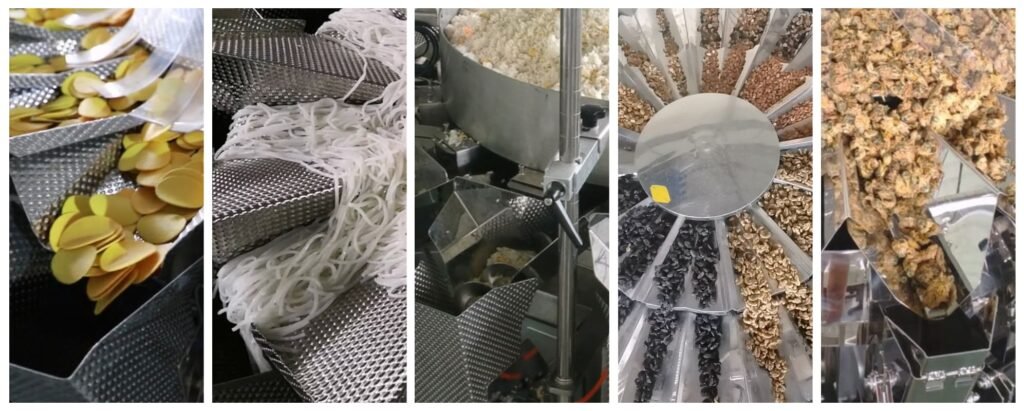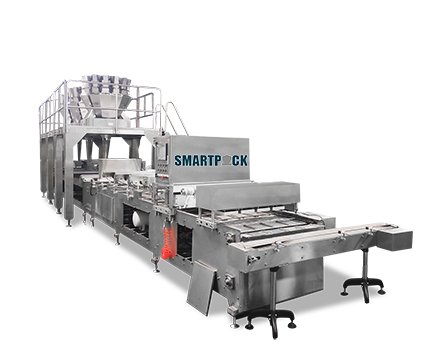
The ready meal sector is going through a big change toward packaging that controls portions. Single-serve and small-format items are driving growth like never before. Market data shows that portion-controlled food packaging is growing at a rate of 8.2% a year. This is because health-conscious customers want easy, low-calorie meal options. Food makers who are switching to making small format ready meals face both new opportunities and new problems because of this shift.
Small format packaging needs very precise engineering that is far more advanced than standard large-batch solutions. When serving 150g-400g servings instead of family-sized dinners, every gram is far more important for making money and keeping customers happy. The margin for mistake gets much less, thus specialist equipment and careful thought about the design of the ready meal packaging line are needed to keep both efficiency and precision.
Understanding Small Format Ready Meal Packaging Requirements
Defining Small Format Portion Packs
Small format ready meal portion packs usually have 150g to 400g of food per serving. They are meant for one person to eat, not for a family to share. These packages come with single-serve trays for meals that can be cooked in the microwave, portion-controlled pouches for high-end items, and small bowls for Asian food. The target group includes busy professionals, health-conscious people who are keeping track of their calories, older people who want smaller amounts, and students who want cheap single meals.
The technological difficulty is to keep the same flavor profiles and nutritional balance that are present in bigger versions while sticking to strict quantity limits. With family-sized dinners, small differences even out over several servings. With small portion packs, though, each one must give the same quality and amount on its own.
Unique Technical Challenges
As the percentage effect of weight changes grows, precise weighing for smaller quantities becomes even more important. A 10g difference in a 300g serving is 3.3% different, while a 1kg family lunch is only 1% different. This level of accuracy is needed throughout the whole packaging process, from measuring out the ingredients to closing the completed box.
When packaging get smaller, food safety becomes more important since the surface area-to-volume ratio is larger, which means there are more places where contamination could happen. Also, smaller parts sometimes need higher production speeds to be economically viable, which might put strain on schedule and lead to lower quality if the right equipment isn’t chosen.
When processing smaller pieces, they heat up and cool down more quickly, making temperature management more difficult. To keep the product’s integrity, you need to be very careful with the environment and speed up the packing cycles. Because small sections have less thermal mass, they are more likely to change temperature during packaging activities.
Critical Equipment Considerations for Small Format Lines
Multihead Weigher Specifications for Small Portions

14 head multihead weigher setups are best for small portions since they give you the accuracy you need to get consistent results while yet keeping production speeds realistic. These devices can usually weigh things that weigh between 50g and 500g with an accuracy range of ±3g, depending on the type of product and the portion size.
Modern multihead weighers for small portions include better software algorithms that make it easier to choose the right combination for narrower weight tolerances. The extra weighing heads give you more options for combinations, which makes it more likely that you will hit your exact target weights while giving up less, which is very important when working with little amounts of high-quality substances.
Systems with an IP65 rating are necessary for washdown conditions that are common in ready meal production. They make sure that equipment lasts longer and that food safety standards are met. The higher protection rating is especially crucial in small format lines, where regular cleaning cycles are needed to keep different food types from mixing together.
Packaging Machine Integration Requirements
Pouch packing systems for pouch applications need particular changes to work with smaller sizes. These changes include making the film width smaller, having more precise sealing controls for smaller packages, and better product distribution systems to make sure that the fill patterns are always the same. These systems need to be able to handle several types of pouches, from stand-up pouches for high-end products to lay-flat designs for applications that don’t want to spend a lot of money.


Small tray sealing machines with precise portion control work perfectly with multihead weighers to make production cells that work well. These machines have flexible tray handling systems, numerous sealing stations for varied tray sizes, and MAP (Modified Atmosphere Packaging) capabilities that are necessary for extending shelf life in smaller pieces where the ratio of surface exposure is higher.
In small format manufacturing, where there is frequently more product diversity than in standard large-format lines, quick changeover features for different SKUs become quite important. Manufacturers sometimes make 15 to 20 distinct tiny portion sizes, but only 5 to 8 family-sized options. This means that how quickly they can switch between them is a key determinant in how profitable they are.
Line Speed and Efficiency Metrics
Target rates for small format lines are usually between 30 and 60 packs per minute. This is a good balance between making things quickly and making sure that the portions are accurate. To keep costs low across a wide range of products, changeover periods between different portion sizes should not be longer than 15 to 20 minutes.
The goal for Overall Equipment Effectiveness (OEE) standards for small format lines is 75–80%. This is a little lower than for large format operations because it’s harder to handle several little sections and changeovers happen more often. But the greater value per pack typically makes these trade-offs in efficiency worth it.
Product-Specific Packaging Considerations
Wet vs. Dry Ready Meal Components
To keep sauce and liquids from spilling and make sure they are evenly distributed, small servings need unique handling devices. For sauce-heavy items, sealing integrity requires better controls for sealing pressure and temperature. This is because smaller packages have less space for sealing, which can lead to contamination of seal zones.
To keep different parts of multi-component meals from getting mixed up, you need accurate dispensing systems and barriers that keep them separate during the packing process. This is especially hard in smaller trays where the walls of the compartments are thinner and more likely to break during filling operations.
Multi-Component Portion Packs
Sequential filling techniques for separating components provide you great control over how proteins, vegetables, and starches are spread out in small containers. These systems connect several weighing and dispensing stations so that meals can be built up layer by layer or compartment by compartment. This makes sure that the meals look good and that the portions are balanced.
The way tiny portion boxes look is much more important because customers can plainly see what is in the whole meal. Consistent placement of protein, sauce, and vegetables, as well as an appealing arrangement of vegetables, become important quality variables that affect customer satisfaction and repeat purchases.
Temperature-Sensitive Ingredients
The packaging for frozen portion packs must be able to handle the particular thermal cycling that happens during small format processing. Because lower mass products change temperature quickly, they need materials that stay flexible and barrier-like throughout a wide range of temperatures and preserve the product well during long periods of frozen storage.
During packaging, it is harder to keep the cold chain going since smaller chunks lose and acquire temperature faster than bulk products. To keep the best processing conditions throughout the packaging cycle, environmental controls need to act rapidly.
ROI and Operational Benefits Analysis
Cost Per Pack Calculations
Automated portioning can save 40–60% on labor costs compared to manual portioning operations. The payback period is usually between 18 and 24 months, depending on how much is being produced. Automated systems are more accurate than hand portioning, which means that the amount of product that goes through is more consistent.
In small format applications, where ingredient costs make up 45–55% of the value of the final product, the effect of lowering the giveaway on profitability is significant. In bigger formats, this percentage is just 35–40%. Getting ±1g accuracy instead of ±5g manual fluctuation can boost margins on high-end goods by 2–3%.
When you switch from manual to automated small format packaging, you usually save 15–25% on material waste. You also save money on packaging material waste since there are fewer packages that are broken or sealed incorrectly during manufacturing.
Quality and Consistency Improvements
Standardized portion sizes across production runs stop customers from complaining about different portion sizes and help develop trust in the brand. Fewer consumer complaints about portion sizes help the brand’s reputation and lower the number of expensive product returns or replacements that hurt small format profitability the most.
Automated processes make it possible to charge more for goods because customers see value in uniform portion sizes and professional presentation that human operations can’t always provide.
Technology Integration and Automation
Smart Weighing Systems
Real-time portion monitoring and modification capabilities allow for quick responses to changes in ingredients or the environment that could affect the accuracy of portions. These systems constantly improve the algorithms used to choose combinations based on the present state of the products and the way they are made.
Collecting data for quality control gives you full traceability and lets you plan maintenance ahead of time to avoid unexpected downtime. When you connect it to factory management systems, you can watch and improve output in real time across many packing lines.
Quality Control Integration
Checkweighing and rejection systems check the final package weights against the specifications and automatically take off any products that don’t meet them from the packaging line. Metal detection systems made for small format applications can handle the smaller product mass while yet meeting food safety standards for sensitivity.
Vision systems for checking package integrity are becoming more significant in small format applications because the quality of the presentation directly affects how well the product is accepted by customers and how long premium prices can last.
Implementation Success Factors
Before/after comparison of manual vs automated small portion packing typically shows 300-400% throughput increases with simultaneous improvement in portion accuracy from ±8g to ±1.5g. Total production cost reductions of 25-35% are common when factoring in labor savings, waste reduction, and improved consistency.
ROI timelines for small format packaging automation investments typically range from 15-30 months, with faster payback periods for high-volume operations and premium product lines where portion accuracy directly impacts profitability.
Conclusion
Small format ready meal packaging has a big chance for growth, but it requires particular equipment and ways of doing business. To be successful, you need precise multihead weighing systems, integrated packaging solutions, and a lot of attention to the special problems that come with making small portions.
To be successful with small format packaging, you should put accuracy ahead of speed, buy machines that can easily switch between different types of packaging, and set up complete quality control systems that make sure all of your products are always the same quality.
Manufacturers thinking about expanding into tiny formats should compare their present operations to the accuracy and flexibility needs listed above. They should focus on choosing equipment that meets both their current needs and their future growth potential in this fast-changing market sector.
